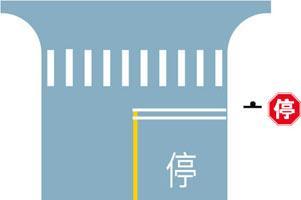1、When parking temporarily on a snowy day, drivers should turn on the headlamp and fog lamp.
A、Right
B、Wrong
Answer:B
2、Which is the wrong measure to avoid tire burst?
A、Reduce tire pressure
B、Check tires regularly
C、Remove foreign matters from the tire tread grooves timely
D、Replace tires that have cracks or deep cuts
Answer:A
3、What should the driver do when the motor vehicle counters this situation?

A、Sound the horn continuously to warn
B、Speed up and bypass from the front
C、Slow down when encountering any risks
D、Slow down voluntarily and yield
Answer:D
4、Which measures is correct when a motor vehicle intends to overtake
A、After overtaking, turn on the right turning light and drive back to the original lane after the necessary safe distance has been pulled away by overtaking.
B、Overtaking from the left side of the previous car
C、After overtaking, turn on the right turn light and drive back to the original Lane immediately.
D、Overtake on the right side
Answer:AB
5、When the vehicles cross each other at night, what should the driver do if the vehicle coming in the opposite direction always use the high beam light.
A、Continuous change lights and honk to remind the vehicle coming in the opposite direction
B、Turn on the high beam light
C、Reduce speed or driving on the right side.
D、Move his sight to the right side to evade the light
Answer:CD
6、Whats the meaning of the double white solid lines in far front of the intersection?

A、Stopping and yield line
B、Slowdown and yield line
C、Left-turn waiting line
D、Waiting to run line
Answer:A
7、When encountering such pedestrians, what should motor vehicle drivers do?

A、Bypass in front of the pedestrians
B、Bypass from behind the pedestrians
C、Sound the horn to alert the pedestrians
D、Voluntarily stop and yield
Answer:D
8、Dangerous chemicals possess the characteristics of explosion, inflammation, poison, erosion and radiation.
A、Right
B、Wrong
Answer:A
9、When approaching a sharp curve, motor vehicle drivers should reduce speed only after entering the curve.
A、Right
B、Wrong
Answer:B
10、How to follow a motor vehicle safely on the road?
A、Observe the front vehicle conditions
B、Drive on the left side of the road as far as possible
C、Be ready to slow down at any time
D、Keep a safe distance
Answer:ACD
11、When encountering this situation in a residential area, the driver may honk to urge them to yield.

A、Right
B、Wrong
Answer:B
12、Speeding up to go though the intersection before the light turns to red in this case.

A、Right
B、Wrong
Answer:B
13、What is the meaning of this sign?

A、The lane for non-motorized vehicles
B、Yield non-motorized vehicles
C、No passing for non-motorized vehicles
D、Watch for non-motorized vehicles
Answer:D
14、When such circumstances happen suddenly, drivers should reduce speed in a timely fashion or stop to yield.

A、Right
B、Wrong
Answer:A
15、The motor vehicle should speed up and pass rapidly under this situation.

A、Right
B、Wrong
Answer:B
16、When a vehicle encounters a strong side wind in a mountain valley, the driver should drastically turn the steering handlebar to adjust the direction of the vehicle if he feels the vehicle deviates from the normal direction.
A、Right
B、Wrong
Answer:B
17、Keep enough safe distance When a motor vehicle follows another vehicle, because ______.
A、Avoke a rear-end collision
B、The closer you get to the vehicle, the less easy it is to grasp the situation ahead of the vehicle.
C、Enough distance to avoid emergencies
D、Prevent being unable to detect the front vehicle brake in time due to the damage rear lamp of the front vehicle
Answer:ABCD
18、When encountering non-motorized vehicles cutting in on the road, the driver should ________.
A、Honk to warn
B、Speed up and bypass from the front
C、Voluntarily reduce speed and yield
D、Suddenly speed up when approaching
Answer:C
19、Which of the following is a safe way for motor vehicles to pass the intersection marked with this sign?

A、Stop and observe the traffic situation around the intersection
B、Approach the intersection by speeding up
C、Observe the traffic situation on the left rear side
D、Approach the intersection at a reduced speed
Answer:D
20、In which of the following ways can motor vehicles avoid a tire burst?
A、Lowering tire pressure
B、Checking tires regularly
C、Removing foreign matters from the tire tread grooves timely
D、Replacing the tires that have cracks or deep cuts
Answer:BCD
21、When driving on a damp and slippery road, drivers should avoid using the emergency brake to his/her best ability.
A、Right
B、Wrong
Answer:A
22、How will the adhesive force of road change when speed increases on a damp and slippery road?
A、Increase sharply
B、Increase gradually
C、Decrease sharply
D、No change
Answer:C
23、When a fast-moving vehicle encounters an emergency the driver should turn to evade first and then brake to slow down so as to mitigate the damage.
A、Right
B、Wrong
Answer:B
24、There is a risk of overtaking when driving a motor vehicle approaches the top of the slope on a mountainous road, because _____.
A、When approaching the top of the slope, the line of sight is blocked and it is impossible to observe the traffic situation.
B、When approaching the top of the slope, the line of sight is blocked. It is impossible to observe whether there are obstacles behind the top of the slope.
C、The speed is slower when approaching the top of the slope.
D、When approaching the top of the slope, the line of sight is blocked and the road direction behind the top of the slope can not be observed.
Answer:ABD
25、How should lamps be used by the motor vehicle driver who follows a vehicle on a road section at night where he street light condition is good?
A、Turn off the headlamp
B、Use high-beam
C、Turn off all lamps
D、Use low-beam
Answer:D